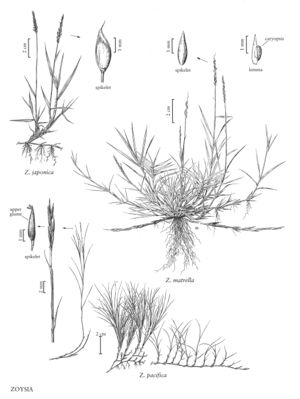Difference between revisions of "Zoysia pacifica"
FNA>Volume Importer |
imported>Volume Importer |
||
| Line 37: | Line 37: | ||
|publication year= | |publication year= | ||
|special status= | |special status= | ||
| − | |source xml=https:// | + | |source xml=https://bibilujan@bitbucket.org/aafc-mbb/fna-data-curation.git/src/bb6b7e3a7de7d3b7888a1ad48c7fd8f5c722d8d6/coarse_grained_fna_xml/V25/V25_928.xml |
|subfamily=Poaceae subfam. Chloridoideae | |subfamily=Poaceae subfam. Chloridoideae | ||
|tribe=Poaceae tribe Cynodonteae | |tribe=Poaceae tribe Cynodonteae | ||
Revision as of 22:06, 27 May 2020
Plants rhizomatous. Sheaths glabrous, overlapping; ligules 0.07-0.25 mm; blades to 3 cm long, to 0.5 mm in diameter, patent, involute to strongly convolute (the margins overlapping), mostly glabrous abaxially, abaxial calluses 0.2-0.6 mm, hairs about 1 mm. Peduncles included or extending to 1 cm beyond the sheaths of the flag leaves. Racemes 0.4-2 cm, with 3-12 spikelets. Spikelets 2.2-2.9 mm long, 0.5-0.8 mm wide, lanceolate to linear, unawned or awned, awns to 0.5 mm. 2n = 40.
Discussion
Zoysia pacifica is less cold-tolerant than either Z. matrella or Z. japonica. It is not a common lawn grass in the Flora region, not even in the southern United States. The cultivar 'Cashmere' has many of the characteristics of Z. pacifica; it is probably derived from a hybrid between Z. matrella and Z. pacifica.
Selected References
None.
